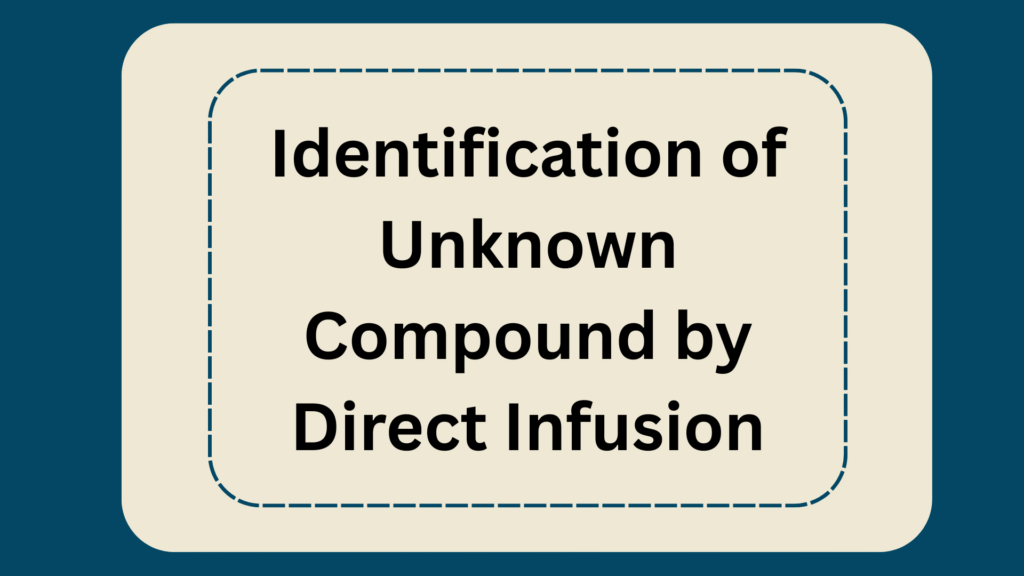Identification of unknown compound by direct infusion
Introduction
In the world of analytical chemistry, the accurate identification of unknown compounds is a critical step in research and quality control. Direct infusion is a powerful technique used for the rapid and effective analysis of compounds without the need for complex sample preparation. At Resolvemass Laboratories Inc., we offer specialized services for the identification of unknown compounds using direct infusion mass spectrometry, providing precise and reliable results for your analytical needs.

What is Direct Infusion?
Direct infusion is a mass spectrometry (MS) technique where a sample is introduced directly into the mass spectrometer without prior separation. This method involves the continuous introduction of the sample into the ion source, allowing for the direct analysis of the sample’s mass-to-charge ratios. It is particularly useful for analyzing small amounts of samples, complex mixtures, or when rapid identification is required.
How Direct Infusion Works
- Sample Introduction: The sample is introduced into the mass spectrometer using a syringe or an infusion pump. This process allows for a continuous flow of the sample into the ionization source.
- Ionization: The sample is ionized in the ion source of the mass spectrometer. Common ionization techniques used in direct infusion include Electrospray Ionization (ESI) and Atmospheric Pressure Chemical Ionization (APCI). These methods generate ions from the sample molecules, which are then introduced into the mass analyzer.
- Mass Analysis: The generated ions are analyzed based on their mass-to-charge ratios (m/z) in the mass analyzer. The mass spectrometer measures the abundance of these ions, creating a mass spectrum that represents the sample’s molecular composition.
- Data Interpretation: The resulting mass spectrum is analyzed to identify the unknown compound. Peaks in the spectrum correspond to different ions, and their m/z values are compared to known reference data or databases to deduce the compound’s identity.
Advantages of Direct Infusion
- Speed and Efficiency: Direct infusion allows for rapid analysis of samples, making it ideal for high-throughput screening and urgent analyses.
- Simplicity: The technique requires minimal sample preparation, which reduces potential errors and increases efficiency.
- Sensitivity: Direct infusion can detect low concentrations of compounds, making it suitable for trace analysis.
- Versatility: It is effective for a wide range of compounds, including small molecules, peptides, and metabolites.
Applications of Direct Infusion
- Drug Development: Identifying unknown metabolites or impurities in pharmaceutical products.
- Environmental Analysis: Detecting and quantifying contaminants or pollutants in environmental samples.
- Food and Beverage Testing: Analyzing the composition and quality of food and beverage products.
- Clinical Research: Identifying biomarkers and other compounds in biological samples.
Our Expertise at Resolvemass Laboratories Inc.
At Resolvemass Laboratories, we utilize advanced mass spectrometry technology and expertise to provide accurate and reliable identification of unknown compounds using direct infusion. Our services include:
- State-of-the-Art Equipment: We employ the latest mass spectrometry systems for high-resolution and accurate mass analysis.
- Experienced Analysts: Our team of skilled scientists is proficient in direct infusion techniques and data interpretation.
- Custom Solutions: We offer tailored services to meet your specific analytical requirements, including method development and validation.
Conclusion
Direct infusion is a valuable technique for the identification of unknown compounds, offering speed, simplicity, and sensitivity. At Resolvemass Laboratories Inc., we are committed to delivering high-quality analytical services to support your research and quality control needs. Contact us today to learn more about how our direct infusion mass spectrometry services can assist you in achieving your analytical goals.
FAQs on Identification of unknown compound by direct infusion
Direct infusion is a mass spectrometry technique where a sample is introduced directly into the mass spectrometer without prior chromatographic separation. It allows rapid detection and analysis of molecular ions and fragments, making it ideal for quick screening of unknown compounds.
Direct infusion generates mass spectra that reveal the molecular weight and structural features of unknown compounds. By analyzing the mass-to-charge (m/z) ratios and fragmentation patterns, researchers can deduce the molecular formula and potential structural elements.
Direct infusion is suitable for a wide range of compounds, including small organic molecules, peptides, metabolites, and natural products. Highly polar, non-volatile, and labile molecules can also be analyzed efficiently with minimal sample preparation.
Direct infusion is fast, requires minimal sample preparation, and allows high-throughput analysis. It provides accurate molecular weight information and can be coupled with tandem mass spectrometry (MS/MS) to obtain structural insights.
A key limitation is the lack of chromatographic separation, which can cause ion suppression or interference from complex mixtures. It is less effective for highly complex or impure samples where overlapping signals may obscure accurate identification.
Sample preparation involves dissolving the unknown compound in a compatible solvent, often with a small amount of acid or base to enhance ionization. Filtration or dilution may be applied to remove particulates and reduce matrix effects.
Ionization, typically using electrospray ionization (ESI) or atmospheric pressure chemical ionization (APCI), is critical for converting molecules into charged ions. Efficient ionization ensures high sensitivity and reliable detection of molecular ions.
Yes, by using tandem mass spectrometry (MS/MS), direct infusion can generate fragmentation patterns that reveal structural features of unknown compounds. This allows identification of functional groups, subunits, and connectivity within the molecule.
Mass spectra are analyzed for molecular ions, isotopic patterns, and fragment ions. Comparing these data with reference databases or theoretical calculations helps determine the molecular formula and possible chemical structure of the unknown compound.
References
- Marques, C., Blaase, L., & Lanekoff, I. (2022). A direct infusion probe for rapid metabolomics of low-chemical-complexity biological samples. Analytical Chemistry, 94(2), 1145–1153. https://doi.org/10.1021/acs.analchem.2c02918
- Bingol, K., & Brüschweiler, R. (2017). Knowns and unknowns in metabolomics identified by multidimensional NMR and hybrid MS/NMR methods. Current Opinion in Biotechnology, 43, 17–24. https://doi.org/10.1016/j.copbio.2016.07.006
- Koulman, A., Tapper, B. A., Fraser, K., Cao, M., Lane, G. A., & Rasmussen, S. (2007). High-throughput direct-infusion ion trap mass spectrometry: A new method for metabolomics. Rapid Communications in Mass Spectrometry, 21(3), 421–428. https://doi.org/10.1002/rcm.2854